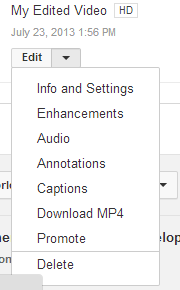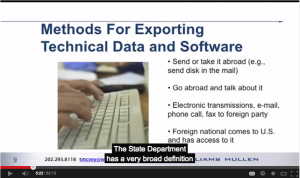Closed captioning literally means that you have to turn on captions—that they’re not “open,” i.e., displayed to all viewers. Captioning, whether open or closed, contains all significant audio content, not just language, and therefore make a video accessible to Deaf and hard of hearing viewers.
Closed captioning is different from a YouTube transcript
YouTube transcripts only contain the text of what is said in the video, and no time code information. YouTube automatically synchronizes the text to your video using speech recognition technology in the same language as the video uses—though YouTube doesn’t support every language. As we’ve written before, uploading transcripts of your videos to YouTube is very useful for SEO, and they do improve your video’s accessibility to people who are hard of hearing. However, they aren’t closed captioning. Transcripts are not designed to include crucial information like (laughs) or (sirens).
Caption files come in specific file formats with file extensions you may not have seen before (.srt, .dxfp, .sami, etc.), and they contain both the text and time codes for when each line of text should be displayed. The way they are constructed enables YouTube’s transcriber to recognize the time information. Here’s what YouTube’s sample of a SubRip (.srt) file looks like:
 You may wish to use a service to prepare your caption file; MiniMatters has worked with netcaptioning.com and recommends them highly. YouTube supports a number of formats; they recommend beginners use .srt or .sbv for closed captions, which you can create with a plain text editor. The video editor allows you to upload your caption to your videos, as shown in the edit menu here (choose “Captions”).
You may wish to use a service to prepare your caption file; MiniMatters has worked with netcaptioning.com and recommends them highly. YouTube supports a number of formats; they recommend beginners use .srt or .sbv for closed captions, which you can create with a plain text editor. The video editor allows you to upload your caption to your videos, as shown in the edit menu here (choose “Captions”).
Closed captioning works on other video platforms too
Here are some specifics about other video platforms:
- Vimeo also allows users to upload caption files to their videos. You go to the video’s advanced settings and upload a file with time markings. The platform supports SRT, WebVTT, DFXP/TTML, SCC, and SAMI files.
- Brightcove supports closed captioning in both SMPTE-TT and DFXP format. You upload through their “Media” module.
- Ooyala supports captions in DFXP format. You upload it through their MANAGE page, after logging in through Backlot.
Closed captioning on YouTube looks like this
 The image here shows how captioning looks on a simple video that MiniMatters produced from our client’s original PowerPoint. This client wanted a quick product that would add audio and closed captioning to his PowerPoint, making it more accessible to his desired audiences and also complying with federal standards for access for people with disabilities.
The image here shows how captioning looks on a simple video that MiniMatters produced from our client’s original PowerPoint. This client wanted a quick product that would add audio and closed captioning to his PowerPoint, making it more accessible to his desired audiences and also complying with federal standards for access for people with disabilities.
Captioning is an element of section 508 compliance—a set of standards to which federal agencies must comply that seeks to make technology accessible to differently-abled people. As we’ll talk about in a post soon, there are many reasons why full 508 compliance is desirable in your videos. But closed captioning (or open captioning) alone is a great way to open up the availability of your video to a wider audience.
If MiniMatters can help you with business video, fundraising video, association video, or other video production needs, we’d love to provide an estimate through our online form, talk with you at 301-339-0339, or communicate via email at [email protected]. We serve associations, foundations, nonprofits, and businesses primarily in Washington, DC, Maryland, and northern Virginia.






